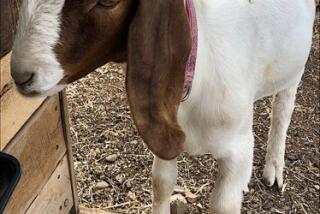San Diego County Fair restricts access to animals after child dies of E. coli complication
All animal exhibits were closed to the public Saturday at the San Diego County Fair in response to the death of a 2-year-old boy who was one of four children suspected of picking up the E.coli bacteria after visiting livestock displays this month.
Dr. Eric McDonald, a county public health official, stressed Saturday morning that the cluster of cases has not yet been definitively linked to fair animals because, in some cases, testing is not yet complete.
But, given that all four infected children visited fair animals before getting sick, and given that preliminary testing was positive for a specific toxin connected to a subspecies of the Escherichia coli bacteria, shutting down animal exhibits, including the event’s popular petting zoo, for the remainder of the fair seemed prudent.
“We have taken this step to restrict access to animals at the fair in an abundance of caution,” said McDonald, medical director of the county public health department’s epidemiology and immunization services branch. “We may find, as the investigation develops, as we develop genetic fingerprints of these organisms, that these cases are not related, that these just happened to be cases that occurred during the summer when it’s more common for these types of cases to occur.”
The boy who died was identified by family on social media as Jedidiah King Cabezuela.
On a GoFundMe page that had already raised $15,000 for funeral arrangements, he was described as “an energetic, smiley, loving, silly 2-year-old precious boy.”
Friends and family held a fundraiser from 4 to 6 p.m. Saturday at Rosie O’Gradys, an Irish pub in San Diego’s Normal Heights neighborhood.
McDonald said the boy suffered from a complication called hemolytic uremic syndrome, which affects about 1 in 10 of those with E.coli infections. The complication occurs when infection leads to damage and inflammation in the kidneys, causing clots that can lead to organ failure. Though the syndrome can happen to anyone, it’s more common in young children.
The boy visited the Del Mar Fairgrounds on June 15, became ill June 19, and died Monday.
Authorities on Saturday provided additional details about the other children involved:
* A 13-year-old girl who visited the fair on June 8 and had symptoms appear June 10;
* An 11-year-old girl who also visited on June 8 with symptoms showing June 12;
*A 9-year-old boy who visited June 13 and started showing symptoms June 16.
The county’s recommendation to shut down the fair’s animal exhibits, including its sprawling livestock exhibits which fill row after row of barns, came Friday, nearly four days after the boy’s death. With symptoms showing up from June 10 through June 16, some have questioned why the action was not taken sooner.
McDonald said that it takes some time for symptoms to turn into doctor’s visits and for those visits to result in testing to indicate that E.coli is or may be present.
It’s only after the public health department is notified of possible infections that public health nurses can begin interviewing subjects and their families, gathering enough facts to determine whether people with similar conditions visited the same places, ate the same food or share some other commonality.
“It really did not come together as a picture until late yesterday,” McDonald said, adding that, in one case, it was only after a third interview that public health investigators learned that one of the four had indeed visited the animal areas of the fair. Investigators have begun to rule out food poisoning.
McDonald and Dr. Wilma Wooten, the county’s public health officer, confirmed Saturday that a full list of everything eaten by all four children was obtained and informed the basis of a investigation by environmental health inspectors Friday.
“We had a detailed list of all of the foods that were consumed by all four of these patients, and our colleagues and environmental health looked at the food preparations for every single place where a food item was reported to us,” McDonald said. “There were no deficiencies found in any of those locations.”
Environmental health inspectors, he added, make daily rounds of fair food vendors to make sure that they’re following safety recommendations.
The E.coli bacteria is best killed by hand washing with soap and water, and fair officials repeatedly advised attendees to wash their hands before indulging in the fair’s gauntlet of food booths.
Fairgrounds chief executive Tim Fennell sent his condolences to the families of those affected by the E.coli infections and said that he has every confidence that fairgoers will be safe attending the remainder of the events on the schedule through July 4, the monthlong attraction’s final day.
“I’m very confident that the fair is safe and secure, and we’re doing everything in our effort to cooperate with the health department,” Fennell said.
The cases in which E.coli infection has been confirmed are of the O157 type responsible for causing food-based outbreaks in recent years.
About 40% of the estimated 265,000 U.S. E.coli cases each year are of the O157 strain, which is known for its ability to cause severe kidney damage, especially in children.
Though fair-related E.coli deaths are rare, they’re not unheard of. In 2016, a 2-year-old Indiana boy died of a similar infection after visiting the petting zoo at the Indiana State Fair, though investigators were unable to definitively link the outcome to animal exposure. In 2015, a 20-month-old boy died of an E.coli infection after visiting a fair petting zoo in Maine. In 2013 the family of a 2-year-old boy sued a county fair after he died following a petting zoo visit in North Carolina.
All four of the San Diego cases are suspected of involving a type of E.coli bacteria that produces shiga toxin, a substance that can cause more severe symptoms. These infections — known as STEC — cause severe abdominal cramps, watery or bloody diarrhea and vomiting with or without a fever.
When fever is present, it is usually in the 101-degree range. The incubation period for the bacteria is between one and 10 days with most cases declaring themselves in two to four days.
Anyone who has experienced these symptoms since June 8 — especially those with diarrhea that lasts for more than three days, bloodly stool, a fever higher than 102 or so much vomiting that they cannot keep liquids down — is urged to seek medical attention.
Sisson writes for the San Diego Union-Tribune.
More to Read
Start your day right
Sign up for Essential California for news, features and recommendations from the L.A. Times and beyond in your inbox six days a week.
You may occasionally receive promotional content from the Los Angeles Times.






